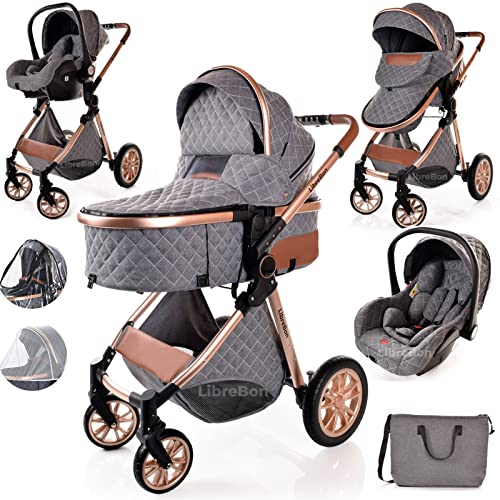Prams and Pushchairs: A Comprehensive Guide for New Parents
Navigating the world of baby transportation can be frustrating for brand-new parents, particularly when it concerns picking in between prams and pushchairs. Each alternative offers unique advantages and limitations, indicating that making a notified decision is essential. This article intends to provide a comprehensive understanding of prams and pushchairs, their differences, functions to think about, and suggestions for selecting the ideal one.
Understanding the Basics: Prams vs. Pushchairs
Prams and pushchairs are terms frequently used interchangeably, however they describe various kinds of baby transportation systems.
Definitions:
- Prams: Traditionally designed for newborns and babies, prams have a big, fully flat bassinet that enables optimal comfort and safety during early stages of a child's life.
- Pushchairs: Designed for older babies and toddlers, pushchairs generally have an upright seat that appropriates for children who can support their head and neck. They often include adjustable recline options.
Secret Differences
| Function | Pram | Pushchair |
|---|---|---|
| Style | Flat bassinet | Upright seat |
| Age Suitability | Newborn to around 6 months | 6 months to 4 years |
| Portability | Usually heavier, less foldable | Typically light-weight and foldable |
| Comfort | Comfortable for newborns, tight fit | Adjustable, can be reclined |
| Usage | Perfect for walks and leisure | Versatile for daily activities and travel |
Functions to Consider When Choosing Prams and Pushchairs
Safety Features
- Harness systems (5-point vs. 3-point)
- Braking systems (foot-operated vs. hand-operated)
- Stability and sturdiness of the frame
Weight and Portability
- Consider the weight of the pram or pushchair
- Search for a model that folds quickly for transport
Size and Storage
- Inspect dimensions for fitting through doorways and in cars and truck trunks
- Search for additional storage alternatives like baskets or pockets
Convenience
- Cushioned seats and adjustable recline positions
- Suspension systems for smoother trips on rough terrains
Weather Protection
- UV security in sunshades
- Alternatives for rain covers and windshields
Wheels and Maneuverability
- Wheel size and type (repaired vs. swivel)
- Suspension systems that assist handling and convenience
Longevity
- Models that convert from pram to pushchair
- Tougher frames that can accommodate growing children
Popular Types of Prams and Pushchairs
When thinking about prams and pushchairs, moms and dads typically discover different styles accommodating specific needs. Here are some widely known types:
1. Standard Prams/Pushchairs
These are great all-rounders, designed for everyday use with a tough frame and sufficient storage area. They are frequently adjustable and can handle different surfaces.
2. Travel Systems
These consist of a safety seat and a stroller that can be utilized together, making it easy to move the baby from the cars and truck to the pram without waking them up.
3. Umbrella Strollers
These are lightweight and foldable, ideal for quick getaways and travel. While practical, they typically do not have a few of the safety and comfort features found in much heavier models.
4. All-Terrain Strollers
Designed for off-road adventures, these strollers have bigger wheels and a more rugged frame, making them ideal for active families.
Choosing the Right Pram or Pushchair
When choosing the ideal pram or pushchair, parents ought to take the following steps:
- Assess Lifestyle Needs: Consider how you will utilize the pram or pushchair (everyday strolls, travel, uneven terrain) and choose accordingly.
- Test Drive: It's helpful to physically check the models at the shop, looking for handling, comfort, and weight.
- Research study Brands: Look at evaluations and suggestions from other parents about specific brand names or models.
- Think About Future Needs: Think ahead to guarantee the option will work as the child grows. Convertible designs offer flexibility.
- Budget: Set a budget but likewise consider quality and durability. In some cases investing more initially can conserve costs in the long run.
Often Asked Questions
What is the very best age to begin using a pushchair?
Most pushchairs can be used for babies from about 6 months old when they can adequately support their heads and necks. Make certain to check the producer's specifications.
Are prams suitable for newborns?
Yes, prams are ideally matched for newborns due to their flat bassinet style, providing a comfortable and secure environment.
How do I clean up a pram or pushchair?
Constantly describe the producer's standards, but most covers are detachable and can be cleaned. Wipe down the frame with a wet fabric and avoid using extreme chemicals.
Can I use a pram or pushchair on public transport?
Different designs differ in size; light-weight and foldable alternatives are normally more ideal for buses or trains. Nevertheless, constantly look for transportation regulations in your location.
For how long can I use a pram or pushchair?
It generally depends on the weight limitation defined by the producer, typically in between 15-50 pounds, or till your kid no longer desires to be pressed.
Selecting in between a pram and a pushchair is a substantial choice that deals with the lifestyle and requirements of both the parent and the kid. By understanding the differences between the 2, evaluating vital features, and picking the best model, moms and dads can guarantee they have a safe, comfortable, and practical transport solution for their little ones.
Arming oneself with knowledge supplies parents not just comfort however likewise the confidence to make the best choice for their kid's early experience into the world. pushchairsandprams require various options, so putting in the time to research and test what fits can reduce a few of the tensions that include new parenthood. Happy walking!

